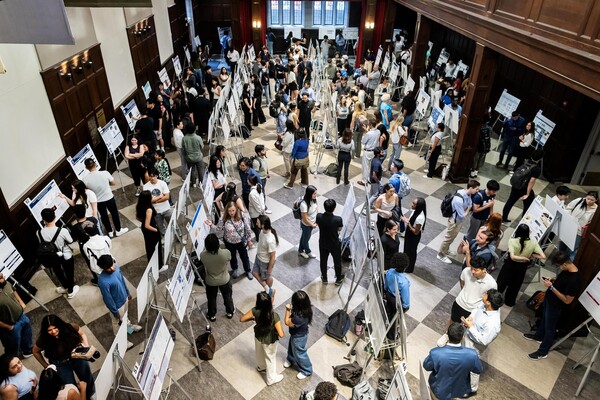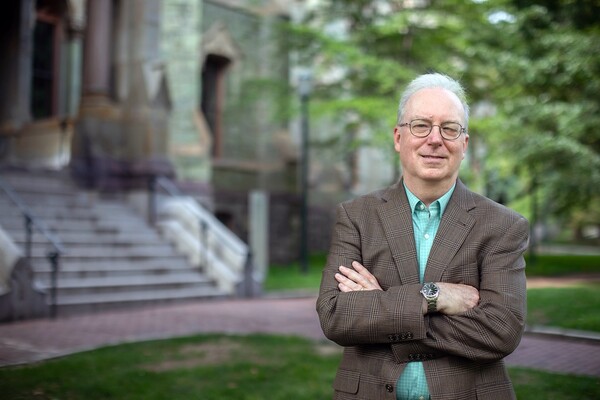
Image: Mininyx Doodle via Getty Images

The practice of redlining prevented people of color from getting access to conventional mortgages, essentially locking African Americans out of the post-World War II housing boom. Historian Brent Cebul in the School of Arts & Sciences studies redlining with digital mapping projects.
Before coming to Penn, Cebul co-authored “Renewing Inequality” at the University of Richmond, a digital historical mapping project that explores the racial inequities of displacement in the federal urban renewal program between 1950 and 1966, highlighting the number of families displaced as their homes and communities were destroyed.
But what about rental availability during that time period? That’s where Cebul’s new digital history project comes in. “Building Inequality” will illuminate the impact of Federal Housing Administration (FHA) credit policies on the availability of affordable rental housing during and immediately following World War II.
This project—which has employed 20 Penn undergraduates, a dozen of whom are active this summer, to help with the research—shifts the focus to FHA-insured apartment complexes. Drawing upon a set of FHA mortgage insurance data that catalogs more than 50,000 FHA-insured apartment buildings, the project is working to map the location, size, and construction dates of roughly 7,000 projects constructed under the FHA wartime and veteran rental housing program (Section 608, 1942-1950.)
“What we are showing here is that the federal government actually was very invested in the production of safe, affordable rental housing. It just wasn’t delivering it in areas that were available to families of color,” Cebul says.
The maps track the federal government’s insurance of mortgages for apartments that were being built. Cebul and his colleague Michael Glass, a historian at Boston College, came across a database of the FHA-insured apartment projects from that time.
“I dropped them into a GIS map and then overlaid racial demographic information, and, sure enough, the vast majority were being built in communities without any statistically significant populations of color,” he says. “We know a great deal about the impact of redlining on entrenching racial inequalities in mortgage markets, but scholars haven’t focused as much on access to rental housing, the production of which was also supported by the same federal programs that proliferated mortgage redlining.”
With such a comprehensive database of tens of thousands of federally backed apartment projects, Cebul, Glass, and their undergraduate researchers are filling in this history, too. The problem with that database, he says, is it doesn’t have the street addresses for more than half of the properties. Now, thanks to a grant from the University Research Foundation and earlier startup grants from the Price Lab for Digital Humanities and the Center for the Study of Ethnicity, Race and Immigration, Cebul has been able to hire undergraduates to search for the street addresses for these rental properties. The students are scouring newspapers, looking for ads for the properties or anything they can find to lead them to a street address. They’re taking that data and plugging it into a GIS map that’s evolving over time.
“What we’re showing here in these maps is that the provisioning of rental housing by the federal government also followed color lines,” Cebul says.
What that meant is that African American residents in many metropolitan areas paid higher rent than white people because they were trapped into segregated communities and slumlords would take advantage of them, he says. “This is often why lots of families lived together, because the rents were higher. And you’d hear people complain ‘Oh, this property is overcrowded,’ and that’s because their rent could be twice as high as rents paid by white people.”
The students are filling in the addresses, including links to the sources, and are making note of interesting historical stories they’re coming across, he says.
“I like to think of us as detectives piecing together these lost histories through the archives,” says rising senior Leo Biehl, who has been working on the project for more than a year. The urban studies and political science double major from Buffalo, New York, has been looking at addresses for New York City, Atlanta, and Los Angeles.
When he started this project, Biehl thought he was just going to be an address finder, but instead he’s found stories that tell how a city has evolved.
For example, in Atlanta, he was searching for a complex called Confederate Acres. He found an address that put it on Confederate Avenue. “So, I was thinking that’s good. But then our next step in the process is always to look on Google Maps. And I was looking everywhere for Confederate Avenue, and I couldn’t find it,” he says. “It turns out that a few years ago, the street was actually renamed to United Avenue, a result of the movements for racial justice.”
Another time, while searching for a building on Rodeo Road in Los Angeles, he discovered the road had been renamed Obama Boulevard a few years ago because that’s where the former president held one of his rallies. Biehl notes that Michelle Obama spent some time in her youth in an affordable housing project in the South Side of Chicago, one that wasn’t financed by conventional banks but instead by a group of interested Black community members who pooled their own resources because they couldn’t get conventional lenders to help them build the housing developments.
"These sorts of stories—where you have Michelle Obama, who grew up in one of these housing complexes and then you have a property in Los Angeles on what is now Obama Boulevard—that, to me, is an incredible parallel,” he says. “Finding all of these stories while I’m looking for addresses has been an informal education in urban history that I never really thought I would get.”
Hadley Degregoris, a rising fourth-year student from Hackettstown, New Jersey, started working on the project in March and is primarily looking at developments in Detroit.
“It’s fun work. Honestly, I feel like I’m kind of doing like a scavenger hunt,” says Degregoris, a history and philosophy double major. “I get to contribute to something much bigger than me and to know that, when the whole thing is done, I’ll have played a part in this important work feels really meaningful.”
She says the work itself has taught her to be very persistent and to think very creatively, and it’s bled into how she approaches other aspects of her life.
“If I’m not getting anything by looking into the historical newspapers, I’ll go to Google Maps, or I can look up the different apartment buildings on Zillow and see when they were built, and that will give me a better sense of if it’s the one I’m looking for. All little workarounds are really interesting and fun,” she says. “I feel like I’m building some better research methods and a better work ethic.”
Jeremy Morton, a rising second-year student from White Plains, New York, who is considering a major in urban studies, took a course his first semester that was taught by Cebul, that looked at the transformation of American cities, which touched on redlining.
“I’m really interested in transportation, infrastructure, and city planning in general, and this project is a great intersection of those topics,” he says.
“I love learning about things that, unexpectedly, I can see in the world around me,” he says. For the mapping project, Morton first looked at his hometown in Westchester County and then expanded into New York City and Long Island. “I’ve found so many apartment buildings that I’ve known about forever but had no clue that they came to be as part of this program. It’s always really interesting when you can learn about something that’s shaped the way your town is and you never knew it existed before.”
He says that, from his own personal experience, as someone with an African American father and a mother of Ashkenazi Jewish descent from Eastern Europe, he’s known that it was harder for his family members in the past to finance mortgages. “But I was not aware of how governmental organizations comprehensively delineated and divided sections of American cities through housing maps they created. I didn’t really know the specifics of how it had worked until I got to Penn,” he says.
Morton says he finds it remarkable that the decisions made in Section 608 housing have ramifications that are felt to this day, pointing to the “windfall scandals” of the 1950s, where many builders of such apartments pocketed millions of dollars of unearned profit from mortgage loans that exceeded construction costs. “I’ve been working on properties in Long Island and Westchester where the developers were walking out with $1 million windfalls in 1950. They were able to create that money in two or three years. You can imagine their descendants are still very much reaping the benefits from that.”
The project, Morton says, has highlighted how important it is to build public awareness about the way federal and state policies affect everyday life. “It’s not talked about enough, but the built environment we have today isn’t just something that happened naturally. It was done systematically,” he says. “It had a massive influence on how our society developed post-war. It’s important that people today are vigilant about monitoring and participating in democracy and government because the way we decide to regulate our society today will still be very visible 50 years or even a century from now.”
For Biehl, looking at the issue of affordable housing today brings the importance of this project into the current moment.
“We’re entering an era where we’re going to have to be crafting a lot of new housing policy and thinking of ways to help with the homelessness crisis,” he says. “It’s important that we look at these past policies to make sure that we don’t make the same mistakes today.”
Kristen de Groot

Image: Mininyx Doodle via Getty Images

nocred

Image: Pencho Chukov via Getty Images

Charles Kane, Christopher H. Browne Distinguished Professor of Physics at Penn’s School of Arts & Sciences.
(Image: Brooke Sietinsons)